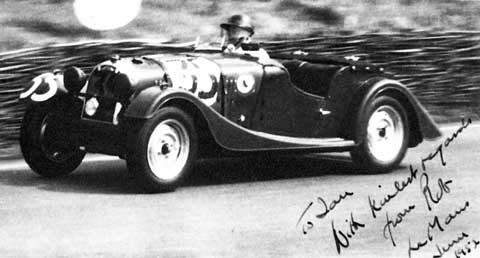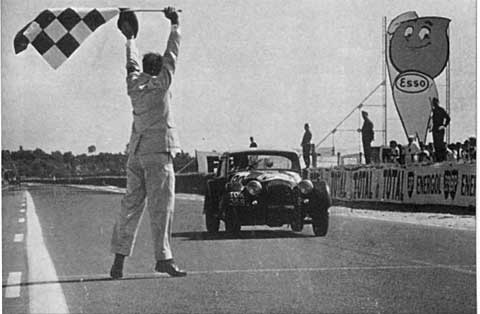 21-22 September 2002
21-22 September 2002
The Le Mans Classic will celebrate 55 years of 24 hour racing on the full Le Mans circuit on 21-22 September 2002.
It is being billed as the world’s largest and most prestigious historic car race of all time.
5 grids of 60 cars are being assembled from the golden years of Le Mans racing, from the inaugural race in 1923 when the race was won by Chenard and Walcker in a car of their own name to 1975 when the Gulf Mirages took charge.
Each grid will set off each hour for about 35 minutes on the full Le Mans circuit for a 24 hour period. This will allow each grid to compete in four races, two during daylight hours and two under the cover of darkness.
The 1923 -1939 Grid
The twenties were dominated by the Bentley Boys but by the start of the 1930s, Alfa Romeo was winning all before them. Other British entries of the period were MG, Aston Martin and the front wheel driven Alvis.
Year |
Drivers |
Car |
Capacity |
Distance |
Speed |
1923 |
Chenard - Walcker |
Chenard Walcker |
3 Litres |
1,372 miles |
57.1mph |
1924 |
Duff - Clement |
Bentley |
3 Litres |
1,290 miles |
53.8mph |
1925 |
De Courcelles-Rossignol |
Lorraine Dietrich |
3.5 Litres |
1,388 miles |
57.9mph |
1926 |
Bloch-Rissignol |
Lorraine Dietrich |
3.5 Litres |
1,586 miles |
66.0mph |
1927 |
Davis-Benjafield |
Bentley |
3.0 Litres |
1,472 miles |
61.4mph |
1928 |
Barnato-Rubin |
Bentley |
4.5 Litres |
1,659 miles |
69.1mph |
1929 |
Barnato-Birkin |
Bentley |
6.5 Litres |
1,767 miles |
73.6mph |
1930 |
Barnato-Kidson |
Bentley |
6.5 Litres |
1,819 miles |
75.8mph |
1931 |
Birkin-Howe |
Alfa Romeo |
2.3 Litres |
1,875 miles |
78.1mph |
Year |
Drivers |
Car |
Capacity |
Distance |
Speed |
1932 |
Sommer-Chinetti |
Alfa Romeo |
2.3 Litres |
1,836 miles |
76.5mph |
1933 |
Sommer-Nuvolari |
Alfa Romeo |
2.3 Litres |
1,954 miles |
81.4mph |
1934 |
Chinetti-Etancelin |
Alfa Romeo |
2.3 Litres |
1,794 miles |
74.7mph |
1935 |
Hindmarsh-Fontes |
Lagonda |
4.5 Litres |
1,868.33 |
77.8mph |
1936 |
CANCELLED |
||||
1937 |
Wimille-Benoist |
Bugatti |
3.3 Litres |
2,044 miles |
85.1mph |
1938 |
Chaubord-Tremoulet |
Delahaye |
3.5 Litres |
1,977 miles |
82.4mph |
1939 |
Wimille-Veyron |
Bugatti |
3.3 Litres |
2,083 miles |
86.8mph |
The thirties saw Alfa Romeo continue their winning ways only to be surpassed by the Bugattis before the out break of war. The British Lagonda Rapide breaking up the run in 1935. Other British success was seen by Aston Martin winning the Biennial Cup in 1932 and 1937 and Riley in1933. MG, Austin, HRG and Singer also made their presence felt.
A Morgan 4-4 was entered in 1938 and 1939 finishing 13th and 15th at average speeds of 57.2mph and 64.4mph respectively. John Clarke and Chris Acklam will be driving a recreation of the 1939 Morgan at the Le Mans Classic.

1938 Le Mans - Chambers & Clarke's HRG waits patiently with Fawcett & White's Morgan (Ref Motor 1938)
1949 – 1956 Grid
Post War, Ferrari entered the fray to take on the mighty Jaguars, Mercedes and Aston Martins. It was all going Jaguar's way through taking five wins out of eight. Jaguar also took the average race speed beyond 100mph for the first time with the remarkable C and D types.
Year |
Drivers |
Car |
Capacity |
Distance |
Speed |
1949 |
Chinetti-Selsden |
Ferrari 166 MM |
2.0 Litres |
1,975 miles |
82.3mph |
1950 |
Rosier-Rosier |
Talbot Lago |
4.5 Litres |
2,153 miles |
89.7mph |
1951 |
Walker-Whitehead |
Jaguar XK120 C |
3.4 Litres |
2,244 miles |
93.5mph |
1952 |
Lang-Reiss |
Mercedes 300SL |
3.0 Litres |
2,320 miles |
96.7mph |
1953 |
Rolt-Hamilton |
Jaguar C |
3.4 Litres |
2,540 miles |
105.8mph |
1954 |
Gonzales-Trintignant |
Ferarri 375 |
5.0 Litres |
2,523 miles |
105.1mph |
1955 |
Hawthorn-Bueb |
Jaguar D |
3.4 Litres |
2,570 miles |
107.1mph |
1956 |
Flockhart-Sanderson |
Jaguar D |
3.4 Litres |
2,507 miles |
104.5mph |
Apart from the Jaguars and Astons, other British makes came to prove themselves at Le Mans with varying levels of success. These included Allard, AC, Arnott, Bentley, Bristol, Connaught, Cooper, Frazer Nash, Healey, HRG, Jowett, Kieft, Lagonda, Lotus, MG, Riley, Singer and Triumph.
In 1952, a Morgan +4 with Vanguard engine entered only to retire from engine failure after 20 laps.

1952 Le Mans - Rob Lawrie in Morgan +4 (Ref 11)
1957 – 1961 Grid
Ferarri took over from Jaguar during the late 1950’s. Gendebein scored a hat trick of wins for Ferrari during this period illustrating as always, that the driver is an important part of the race winning package as the car.
Year |
Drivers |
Car |
Capacity |
Distance |
Speed |
1957 |
Flockhart-Bueb |
Jaguar D |
3.8 Litres |
2,732 miles |
113.8mph |
1958 |
Gendebien-Hill (P) |
Ferrari 250 TR |
3.0 Litres |
2,549 miles |
106.2mph |
1959 |
Salvadori/Shelby |
Aston Martin DBR 1 |
3.0 Litres |
2,702 miles |
112.6mph |
1960 |
Frere-Gendebein |
Ferarri TR 60 |
3.0 Litres |
2,621 miles |
109.2mph |
1961 |
Gendebien-Hill (P) |
Ferrari 250 TR |
3.0 Litres |
2,782 miles |
115.9mph |
Again, the British manufacturers turned out in numbers to support Le Mans and included teams from AC, Austin Healey, Cooper, Frazer Nash, Lister, Lotus, Marcos, MG, Rover-BRM, Sunbeam, Tojeiro and Triumph.
1962 – 1965 Grid
Ferrari dominated the early 1960s with Gendebein adding to his hat trick of wins.
1962 saw Morgan’s finest hour with the Morgan +4 driven by Lawrence and Shepherd- Barron winning the 2.0 Litre class at an average speed of 94mph. This Morgan will be reappearing at the Le Mans Classic again driven by Chris Lawrence but partnered by its new owner, Rick Bourne, and Rob Wells.

1962 Le Mans - Chris Lawrence & Richard Shepherd-Barron in class winning Morgan +4 'TOK'
|
Year |
Drivers |
Car |
Capacity |
Distance |
Speed |
|
1962 |
Gendebein-Hill (P) |
Ferrari 330LM |
4.0 Litres |
2,766 miles |
115.2mph |
|
1963 |
Scarfiotti-Bandini |
Ferrari 250 P |
3.0 Litres |
2,835 miles |
118.1mph |
|
1964 |
Guichet-Vaccarella |
Ferrari 275 P |
3.3 Litres |
2,918 miles |
121.6mph |
|
1965 |
Gregory-Rindt |
Ferrari 275 LM |
3.3 Litres |
2,906 miles |
121.1mph |
By 1963 British interest had waned with only three British manufacturers taking part.
1966 – 1975 Grid
Ford were the dominant force by the mid 1960s with the hugely successful GT40. However, the 1970s belonged to Porsche covering distances that have yet to be beaten. With the regulations changed in 1972, some say to favour the French, Pescarolo took the first of a hat trick of wins in the French Matra Simca.
|
Year |
Drivers |
Car |
Capacity |
Distance |
Speed |
|
1966 |
McLaren-Amon |
Ford Mk 2 |
7.0 Litres |
3,009 miles |
125.4mph |
|
1967 |
Gurney-Foyt |
Ford Mk 4 |
7.0 Litres |
3,251 miles |
135.5mph |
|
1968 |
Rodriguez-Bianchi |
Ford GT40 |
5.0 Litres |
2,767 miles |
115.3mph |
|
1969 |
Ickx-Oliver |
Ford GT40 |
5.0 Litres |
3,106 miles |
129.4mph |
|
1970 |
Mermann-Atwood |
Porsche 917 |
4.5 Litres |
2,863 miles |
119.3mph |
|
1971 |
Marko-Van Lennep |
Porsche 917 |
5.0 Litres |
3,315 miles |
138.1mph |
|
1972 |
Pescarolo-Hill |
Matra Simca |
3.0 Litres |
2,915 miles |
121.5mph |
|
1973 |
Pescarolo-Larrouse |
Matra Simca |
3.0 Litres |
3,016 miles |
125.7mph |
|
1974 |
Pescarolo-Larrouse |
Matra Simca |
3.0 Litres |
2,862 miles |
119.2mph |
|
1975 |
Bell-Ickx |
Gulf Mirage |
3.0 Litres |
2,854 miles |
118.9mph |
By 1966 British manufacturers seemed to have deserted Le Mans with only a few cars entered. Those that still entered the fray were Austin Healey, Chevron, Duckham Ford, Gulf, Lola, Marcos and Piper.
What else is going on at Le Mans Classic?
Aside from the magnificent racing, there is expected to be a huge gathering of classic cars from all over Europe. There will be a myriad of stalls selling everything from spare parts to luxury products and an auction of classic cars.